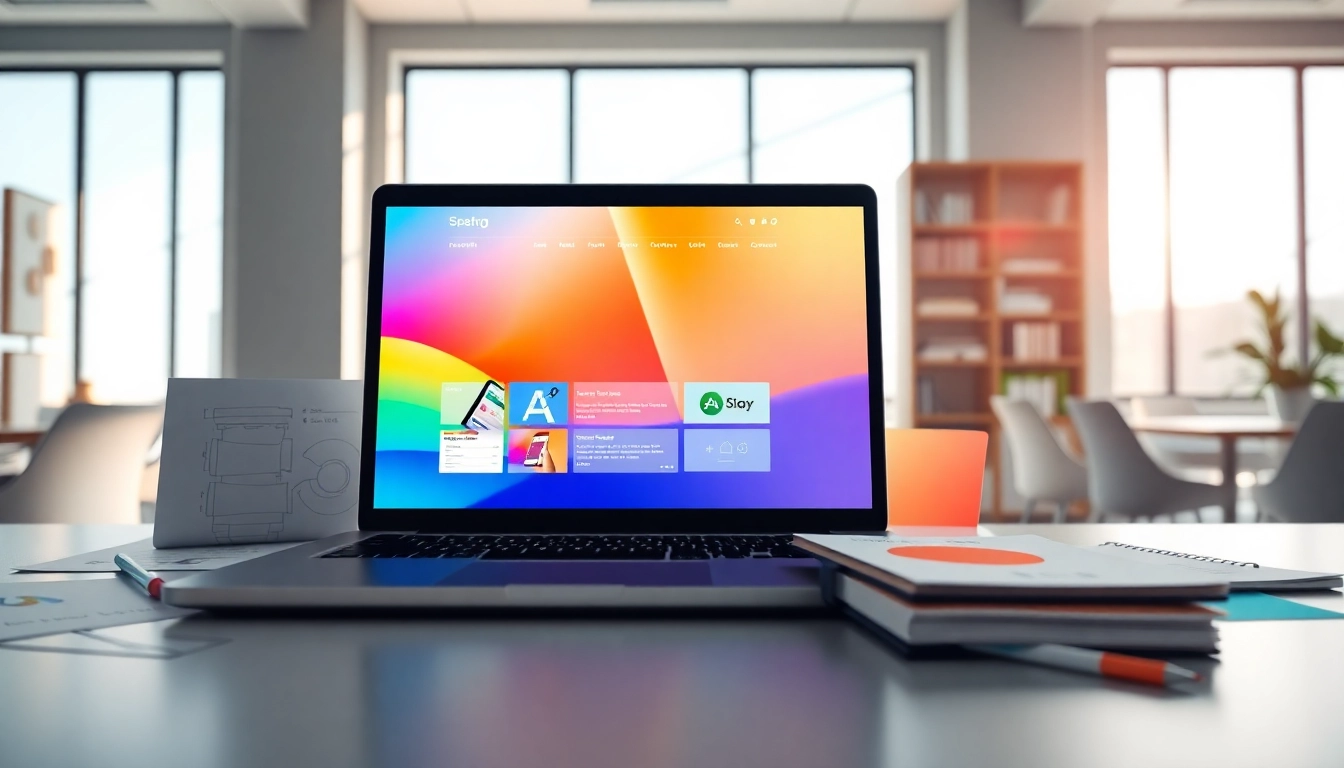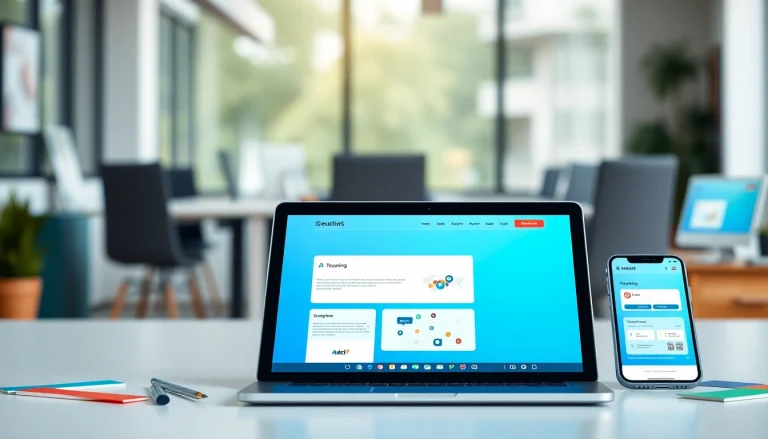Understanding the Essentials of Website Design
Website design is a multifaceted discipline that involves various skills and principles in the creation and maintenance of websites. From layout to color palettes to user experience, effective website design is crucial for engaging users and achieving business objectives. The process requires a careful balance between aesthetics and functionality to create a digital space that resonates with users. The significance of a well-executed website design cannot be underestimated, as it directly influences user retention and interaction rates.
Defining Key Concepts in Website Design
To navigate the world of website design, it is essential to comprehend several foundational concepts:
- Web Graphics: This refers to the visual elements used in a website, including images, icons, and graphics that enhance the aesthetic quality.
- User Interface (UI) Design: UI design focuses on optimizing the interaction between users and web elements, ensuring that navigation is intuitive and efficient.
- User Experience (UX) Design: UX design involves understanding user behavior and creating a seamless experience that meets their needs while interacting with the website.
- Responsive Design: A vital aspect of modern website design, responsive design ensures that websites function effectively across a range of devices and screen sizes, providing a consistent experience.
Importance of User Experience in Website Design
User experience is a pivotal element in website design. A well-designed UX leads to higher user satisfaction, retention, and ultimately, conversion rates. Key components contributing to effective UX include:
- Navigation: Clear navigation helps users find information easily, improving their overall experience.
- Loading Speed: Websites need to load quickly to reduce bounce rates; a delay of even a few seconds can deter users.
- Accessibility: Ensuring that websites are accessible to all users, including those with disabilities, is critical and can positively impact a website’s reach.
Analyzing the Trends in Website Design
Website design is constantly evolving, influenced by technological advancements and changing user preferences. Some notable trends include:
- Minimalism: A clean design with ample white space often helps improve user focus.
- Bold Typography: Large, eye-catching fonts can effectively convey messages while enhancing brand identity.
- Dark Mode: Its rise in popularity presents a modern aesthetic that many users prefer for its comfort and style.
Best Practices for Website Design
Creating a Responsive Website Design
Responsive design is vital for ensuring that websites provide optimal experiences across various devices. Strategies for effective responsive design include:
- Flexible Grids: Using relative units like percentages rather than fixed units ensures elements adjust seamlessly across devices.
- Media Queries: CSS media queries help to apply specific styling rules based on the device characteristics such as screen width.
- Fluid Images: Ensuring images resize correctly within their containing elements prevents layout breakage.
Utilizing Color Theory in Website Design
Color theory plays a significant role in how users perceive a brand and their emotional response to a website. Key considerations include:
- Color Psychology: Different colors evoke different feelings; for example, blue often symbolizes trust and security, while orange can create a sense of urgency.
- Brand Consistency: Maintaining consistent color schemes helps establish a strong brand identity and recognition.
- Contrast: Ensuring high contrast between text and background increases readability and accessibility.
Incorporating Typography Effectively in Website Design
Typography significantly affects the readability and overall aesthetic of a website. Best practices include:
- Font Selection: Choose fonts that are both aesthetically pleasing and easy to read. Limit the number of font styles to maintain visual coherence.
- Hierarchy: Use different font sizes and weights to create a clear hierarchy, guiding the users’ attention to critical information.
- Line Spacing: Proper line spacing enhances readability, ensuring that content is engaging and easy to digest.
Common Challenges in Website Design
Navigating Technical Issues in Website Design
Technical challenges often arise during the web design process, such as:
- Browser Compatibility: Different browsers can render websites differently; thorough testing across multiple platforms is essential.
- Performance Optimization: Slow loading speeds can be caused by unoptimized images or excessive scripts; regular audits can identify bottlenecks.
Balancing Aesthetics and Functionality in Website Design
Finding the right balance between aesthetic appeal and practical functionality is critical. This can be achieved by:
- Prioritizing User Needs: Design should focus on meeting user needs without compromising design quality.
- Usability Testing: Regularly testing with real users can provide insights into their preferences and pain points, guiding adjustments to both aesthetics and functionality.
Addressing User Accessibility in Website Design
Creating accessible websites benefits all users and broadens the audience reach. To enhance accessibility:
- Alt Text for Images: Providing descriptive alt text ensures that visually impaired users can understand the content of images.
- Keyboard Navigation: Ensuring that all interactive elements can be accessed using a keyboard enhances usability for individuals with disabilities.
- Color Contrast Tools: Utilizing tools to check color contrast ratios ensures that text is legible against its background for all users.
Tools and Resources for Website Design
Exploring Software Options for Website Design
A plethora of software tools exists for website designers, providing essential functionalities. Some notable categories include:
- Graphic Design Software: Tools like Adobe Photoshop and Illustrator enable designers to create stunning graphics.
- Prototyping Tools: Services like Figma or Sketch allow designers to visualize designs and collaborate effectively.
- Code Editors: Applications such as Visual Studio Code and Sublime Text are popular among developers for writing and editing code efficiently.
Leveraging Templates in Website Design
Templates can significantly accelerate the web design process. They provide a good foundation while allowing for customization. However, designers should:
- Choose Quality Templates: Invest in professionally designed templates to ensure high quality and usability.
- Modify Templates for Unique Branding: While templates offer a good starting point, customization will help establish brand identity.
Using Analytics to Optimize Website Design
Analyzing user data is essential for optimizing website design. Useful practices include:
- Track User Behavior: Use tools like Google Analytics to gain insights into how users interact with your site.
- A/B Testing: Implement variations of web pages to determine which designs perform better with real users.
- Regularly Review Analytics Reports: Assessing data will inform design improvements and highlight areas that need attention.
Future Trends in Website Design
Anticipating Technological Innovations in Website Design
Technological advancements are shaping the future of website design. Key trends to watch include:
- Augmented Reality (AR): Integrating AR can provide immersive experiences, enriching the way users interact with websites.
- Voice User Interface (VUI): As voice search grows, optimizing for voice commands will become a critical element of website design.
Predicting User Preferences for Website Design
Understanding evolving user preferences is essential for future-proofing web design. Factors influencing preferences include:
- Personalization: Users increasingly expect websites to cater to their preferences and behaviors.
- Interactive Elements: Gamification and interactive components enhance user engagement and satisfaction.
The Role of AI in Shaping Website Design
Artificial intelligence is transforming website design processes through:
- Automated Design Tools: AI-driven platforms can automatically generate website designs based on user input, simplifying the design process.
- Predictive Analysis: Leveraging AI to analyze user behavior can inform adjustments for enhancing UX and conversion rates.








